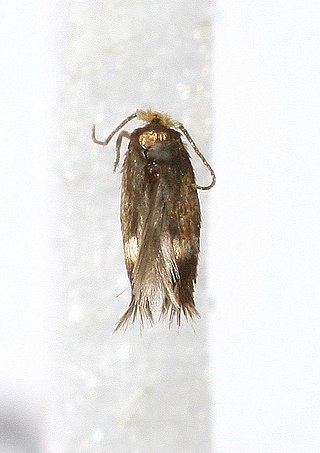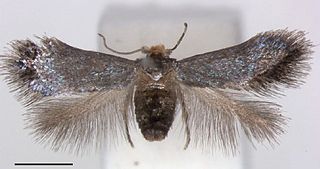
Nepticulidae is a family of very small moths with a worldwide distribution. They are characterised by eyecaps over the eyes. These pigmy moths or midget moths, as they are commonly known, include the smallest of all living moths, with a wingspan that can be as little as 3 mm in the case of the European pigmy sorrel moth, but more usually 3.5–10 mm. The wings of adult moths are narrow and lanceolate, sometimes with metallic markings, and with the venation very simplified compared to most other moths.

Stigmella microtheriella is a moth of the family Nepticulidae, found in Asia, Europe and New Zealand. The larvae mine the leaves of hazel and hornbeams. It was described by the English entomologist, Henry Tibbats Stainton in 1854 from a type specimen found in England.
Stigmella oxyacanthella is a moth of the family Nepticulidae, found in Europe and North America. The larvae are leaf miners feeding inside the leaves of trees and shrubs, such as hawthorn, apple and pear.

Stigmella ruficapitella is a moth of the family Nepticulidae. It is found in northern and central Europe. It is mostly absent in the Mediterranean region, with the exception of Mount Olympus in Greece and Trieste. It has recently been recorded from Russia and Bosnia.

Stigmella crataegella is a moth of the family Nepticulidae found in Europe. It was described by the Austrian entomologist Josef Wilhelm Klimesch in 1936. The larvae mine the leaves of hawthorns.
Stigmella castanopsiella is a moth of the family Nepticulidae. It is only known from Honshū and Kyushu in Japan, but is probably also present in China.
Stigmella zelkoviella is a moth of the family Nepticulidae. It is only known from Kyushu in Japan.
Roscidotoga callicomae is a moth of the family Nepticulidae. It is found along the south-eastern coast of New South Wales and in Queensland.
Roscidotoga eucryphiae is a moth of the family Nepticulidae. It is found in Tasmania.
Roscidotoga sapphiripes is a moth of the family Nepticulidae. It is found along the north-eastern coast of Queensland.

Stigmella kaimanua is a moth of the family Nepticulidae. This species is endemic to New Zealand and has been observed in the southern parts of the South Island. S. kaimanua inhabits lowland and lower montane forest. The larvae mine the leaves of Parsonsia heterophylla. The mine is linear and continues down the stems for a short distance. Larvae have been observed April to August. The cocoon is probably attached to the leaf litter on the ground under the host plant. There is one generation per year. Adults are on the wing in November and December and are attracted to light.
Trifurcula eurema is a moth of the family Nepticulidae. It is widespread throughout Europe, northwards to southern Norway and Sweden, Poland and the Baltic Region. It is also found in the Mediterranean region, including the larger Mediterranean islands, east to Bulgaria, Asiatic Turkey and Ukraine.

Cosmopterix clandestinella is a moth of the family Cosmopterigidae. It is known from the United States.
Elachista habrella is a moth of the family Elachistidae. It is found along the eastern coast of New South Wales and Queensland.
Antispila corniella is a moth of the family Heliozelidae. It was described by Kuroko in 1961. It is found in Japan (Kyushu).

Pectinivalva brevipalpa is a moth of the family Nepticulidae. It is found in New South Wales.

Pectinivalva minotaurus is a moth of the family Nepticulidae. It is found in southern Queensland.

Pectinivalva scotodes is a moth of the family Nepticulidae. It is found in New South Wales and southern Queensland.

Pectinivalva quintiniae is a moth of the family Nepticulidae. It is found in northern New South Wales and southern Queensland.

Pectinivalva tribulatrix is a moth of the family Nepticulidae. It is found in northern Queensland.









